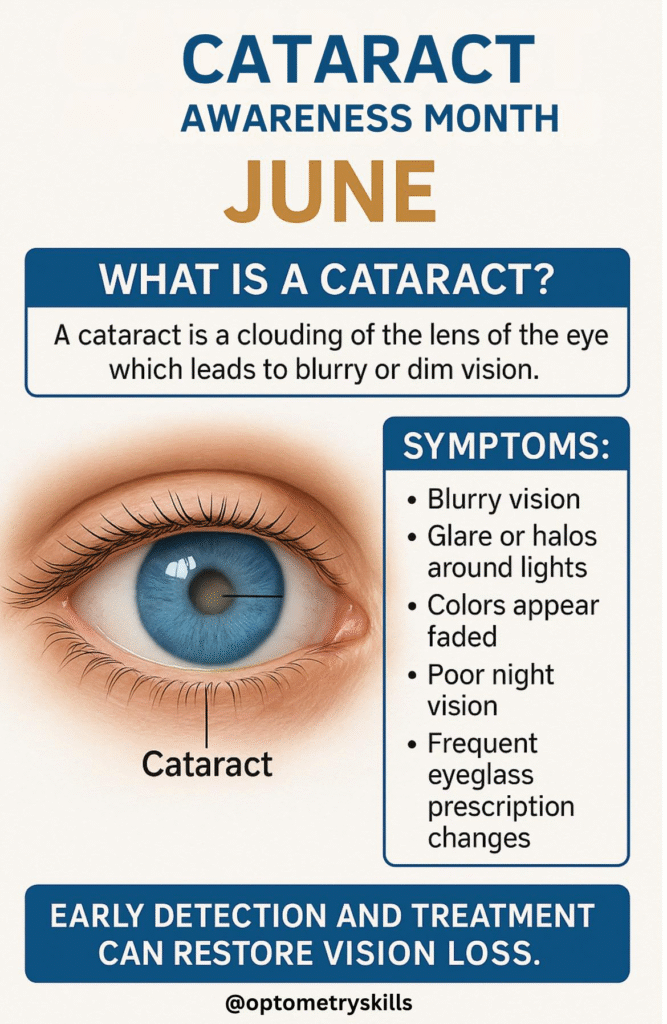

What Is Cataract Awareness Month?
Every June, eye care professionals across the country observe Cataract Awareness Month to educate the public about one of the leading causes of vision loss worldwide—cataracts. This awareness campaign serves as a reminder to prioritize regular eye exams, especially as we age, and to spread the word about the importance of early detection and treatment.
Cataracts are more common than many people realize, but the good news is: they are also treatable.
What Is a Cataract?
A cataract is the clouding of the natural lens of the eye, which lies behind the iris and the pupil. This cloudiness blocks light from passing clearly through the lens, causing blurred or hazy vision.
Cataracts develop gradually and are most often related to aging. By the age of 80, more than half of people either have a cataract or have had cataract surgery.
Common Symptoms of Cataracts
Cataracts usually develop slowly and painlessly. You might not notice symptoms at first, but over time, you may experience:
- Blurry or cloudy vision
- Glare or halos around lights
- Difficulty seeing at night or in low light
- Faded or dull colors
- Frequent changes in eyeglass prescription
- Double vision in one eye
If you notice any of these symptoms, it’s important to have your eyes examined by an optometrist or ophthalmologist.
Who Is at Risk?
While age is the most common risk factor, other factors can increase your likelihood of developing cataracts, including:
- Family history of cataracts
- Diabetes
- Smoking
- Excessive alcohol consumption
- Prolonged exposure to UV rays without protection
- Use of certain medications, such as steroids
- Eye injuries or previous eye surgeries
How Are Cataracts Diagnosed?
Cataracts are diagnosed through a comprehensive eye examination, which may include:
- Visual acuity testing
- Slit-lamp examination to view the lens in detail
- Retinal examination to rule out other causes of vision loss
These tests allow eye care providers to assess the severity of the cataract and decide the best course of treatment.
Can Cataracts Be Prevented?
While cataracts cannot always be prevented, certain lifestyle habits can help reduce the risk or slow their progression:
- Wear sunglasses that block 100% of UVA and UVB rays
- Avoid smoking
- Eat a healthy diet rich in antioxidants (like leafy greens, fruits, and fish)
- Manage chronic conditions such as diabetes
- Get regular eye exams, especially after age 40
Early detection can make a significant difference in maintaining clear vision for longer.
What Is the Treatment for Cataracts?
When cataracts begin to interfere with daily life, cataract surgery is the most effective treatment. This procedure involves removing the clouded lens and replacing it with a clear artificial intraocular lens (IOL).
Cataract surgery is one of the most commonly performed surgeries worldwide and has a high success rate in restoring vision.
Why Cataract Awareness Month Matters
Cataract Awareness Month serves as a valuable opportunity to:
- Encourage regular eye exams, especially in adults over 50
- Raise awareness about the signs and symptoms of cataracts
- Educate patients about treatment options
- Promote healthy lifestyle habits that protect eye health
Many people delay cataract treatment because they think vision loss is a normal part of aging. But cataracts are treatable, and early diagnosis can help preserve quality of life.
Final Thoughts
This June, take a moment to prioritize your vision or encourage a loved one to schedule an eye exam. Cataracts are common, but with the right care, they don’t have to interfere with living a full and active life.
If you haven’t had an eye exam recently—or if you’re noticing changes in your vision—Cataract Awareness Month is the perfect reminder to take action.
Protect your sight. Get informed. And help others do the same.
